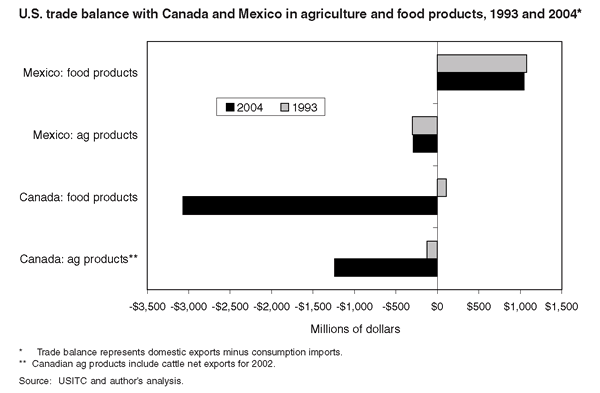See Snapshots Archive.
Snapshot for June 8, 2005.
CAFTA outlook clouded by NAFTA’s failure for farmers
Promoters of the proposed Dominican Republic/Central American Free Trade Agreement (CAFTA) have asserted that it will provide significant benefits to the agricultural sector. Similar promises were made in the debate over the North American Free Trade Agreement in 1992 and 1993. Unfortunately, the results never lived up to the promises.
U.S. trade and agricultural officials predicted that NAFTA would expand farm production and jobs in the United States But a truly accurate measure of the overall effects of trade on the economy requires taking into account both imports and exports. If officials’ predictions had been accurate, the U.S. trade balance should have improved since 1993, the year before NAFTA took effect.
The figure below compares U.S. trade balances in agricultural and food products with those of Canada and Mexico in 1993 and 2004. Mexico stands out because there is simply no significant change in the trade balance in either agricultural or food products. Although two-way trade with Mexico has expanded, it has not provided a net stimulus of any kind to either sector.

The figure also depicts the sharp increase in U.S. trade deficits with Canada under NAFTA in both agricultural and food products. The U.S. farm deficit with Canada increased from $100 million in 1993 to $1.1 billion in 2004 (U.S. International Trade Commission 2005). What had been, in 1993, a $1.2 billion U.S. food products surplus with Canada was transformed by 2004 into a $3.1 billion deficit. Thus, the U.S. trade balance with Canada in food and agricultural products suffered a net decline of $4.3 billion.
The predicted increase in the U.S. trade balance with Mexico did occur for some specific products, but that was often offset by a larger decline in the trade balance with Canada. For example, the USDA (1993) claimed that “grains and meats are expected to account for the majority of the expanded value of U.S. agricultural trade,” noting that “Mexico is one of the fastest growing export markets for U.S. meat.” While the U.S. surplus in meat products with Mexico expanded by $1.2 billion, this was more than offset by a $1.5 billion increase in the deficit in U.S. meat trade with Canada. In effect, all the gains from expanded meat trade accrued to Canada, and U.S. farmers, ranchers, and meat packers were left empty-handed.
If there is a lesson to be learned from NAFTA’s failures, it is that today’s claims of great CAFTA benefits should be taken with a grain of salt.
For additional analysis of the CAFTA proposal, see the EPI Issue Brief Will CAFTA Be a Boon to Farmers and the Food Industry?
References
USDA, Office of Economics. 1993. “Effects of the North American Free Trade Agreement on U.S. Agricultural Commodities.” March.
U.S. International Trade Commission. 2005. “Interactive Tariff and Trade Dataweb,”
Today’s Snapshot was written by EPI economist Robert E. Scott.
